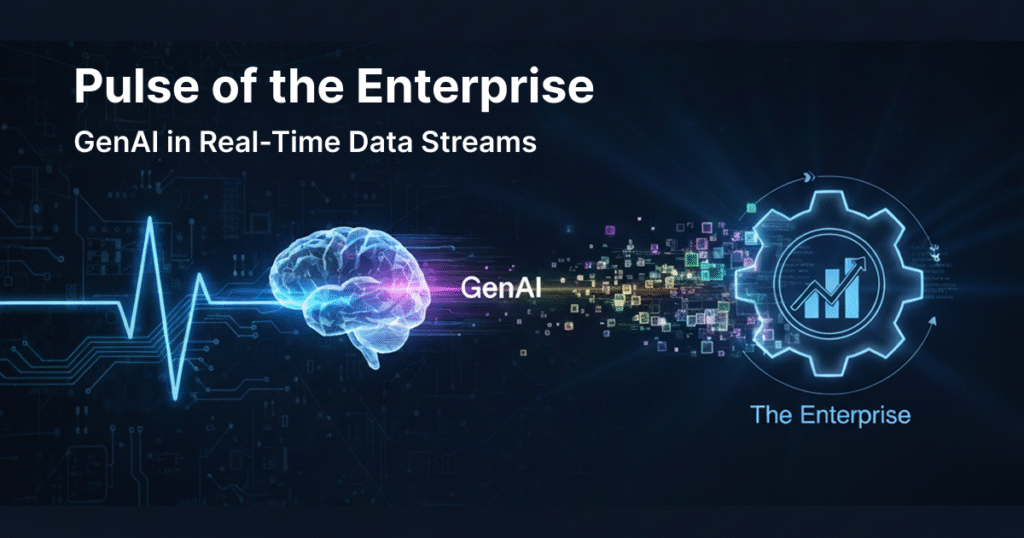Enterprises today run on data. But data isn’t just static rows in a database anymore—it’s alive, moving, and changing every second. Customer interactions, IoT sensors, financial transactions, and supply chain events all generate real-time streams of data. This is where Generative AI (GenAI) steps in. By blending streaming analytics with AI-driven reasoning, enterprises can move from reactive dashboards to proactive intelligence. GenAI is no longer just creating content; it’s becoming the pulse of the enterprise, guiding decisions in real-time.

How GenAI Enhances Real-Time Streams
GenAI enhances real-time data streams in multiple ways. Through stream summarization, instead of analysts digging into thousands of Kafka or Kinesis messages, GenAI provides concise, actionable summaries such as, “Top 3 anomalies detected in transactions this hour.” This drastically reduces human effort and enables faster reactions to changes in business dynamics.
Another powerful application lies in predictive flow control. GenAI anticipates what’s coming based on past signals, predicting events such as equipment failure from IoT telemetry or forecasting customer churn by analyzing behavioral trends. It transforms enterprises from being reactive to preemptive, enabling interventions before issues arise.
Finally, with natural language interfaces, decision-makers no longer need technical queries. Executives can simply ask questions like, “Show me real-time sales spikes in APAC for the last 10 minutes,” and GenAI translates that into complex streaming queries in the background, delivering results in seconds.
Architectural Blueprint: How It All Connects
A modern GenAI and streaming architecture is composed of several tightly integrated layers. The ingestion layer leverages platforms such as Kafka, Kinesis, or Pulsar to collect real-time events from multiple systems. The processing layer, often powered by Spark Streaming, Flink, or Materialize, manages complex computations and stateful transformations on streaming data. Above that, the GenAI reasoning layer, enabled by large language models such as GPT or Claude, provides contextual understanding, summarization, prediction, and anomaly explanations. Finally, the visualization and decision layer turns these AI-driven insights into intuitive dashboards, chatbots, or automated workflows, allowing users to act instantly.
Together, these components form a continuous feedback loop—where each decision refines future predictions, ultimately transforming enterprises into adaptive systems capable of learning in real time.
Enterprise Impact
The enterprise impact of combining GenAI with real-time data streams is profound. Decision-making accelerates from hours to milliseconds, enabling instant responses to business events. Customer experiences become deeply personalized, as dynamic offers and engagement models adapt in real-time. Operational resilience improves through early detection of disruptions and anomalies, ensuring business continuity. Most importantly, organizations gain a sustainable competitive edge by transforming streaming data into continuous cycles of innovation.
Challenges to Overcome
Despite its promise, enterprises face key challenges when implementing GenAI in streaming environments. Data governance remains a priority—ensuring accuracy, security, and compliance for constantly flowing data. Scalability is another concern, as managing petabytes of event streams demands optimized infrastructure and resource management. Finally, trust in AI must be established by preventing hallucinations and ensuring decisions are explainable and auditable across business functions.
Pros and Cons of GenAI in Real-Time Data Streams
Pros
Real-time decision making and faster response to business events.
Improved personalization for customers, leading to higher engagement.
Enhanced operational efficiency through predictive analytics.
Ability to automate repetitive tasks and reduce manual workload.
Cons
High infrastructure and maintenance costs.
Risks of inaccurate or biased AI outputs affecting real-time actions.
Increased complexity in managing and monitoring data pipelines.
Potential regulatory challenges due to sensitive data handling.
Future Outlook
The fusion of GenAI with real-time data streams is redefining enterprise workflows into living, breathing systems. Businesses that master this pulse won’t just keep up with the future—they will set its rhythm. The next generation of enterprises will not only analyze data but also sense and adapt to changes autonomously. This evolution will turn organizations into dynamic, intelligent ecosystems capable of responding instantly to global market shifts.
Brigita’s Role in Building Real-Time AI Enterprises
At Brigita.co, we enable organizations to orchestrate this transformation with a unified, AI-powered streaming intelligence architecture. Our systems integrate Kafka, Kinesis, and Flink pipelines infused with GenAI models that summarize, predict, and automate real-time workflows. We ensure transparency through explainable AI frameworks, embedding trust in every inference cycle. Additionally, our scalable deployment models are cloud-agnostic, ensuring optimal performance, resilience, and cost efficiency across infrastructures.
With Brigita’s expertise, enterprises can evolve from being merely data-driven to truly AI-synchronized—operating at the pulse of their real-time ecosystems.
Conclusion
Generative AI in real-time data streams is not just a technological enhancement; it’s a strategic transformation. Enterprises that adopt this convergence will transition from reacting to anticipating, from dashboards to decision flows, and from static reporting to living intelligence. Much like how AI revolutionized marketing and customer engagement, it now redefines how enterprises think, operate, and innovate. Brigita’s “Pulse of the Enterprise” framework empowers organizations to sense, decide, and act—instantly. In the era of GenAI and real-time data, timing isn’t just important—it’s everything.
Search
Categories

Author
-
Hari is a backend developer with 2 years of hands-on experience building scalable and efficient systems.He’s worked in Django and Python applications. Over the past two years, he’s worked on streamlining backend processes, optimizing data flows, and collaborating across teams to ensure systems are both reliable and performance-driven. I enjoy diving deep into backend logic, automating data tasks, and making sure information moves seamlessly through complex systems.Always eager to learn new technologies and he’s into vibe coding tools like Chatgpt,Gemini, Moreover he’s a football addict and a Reader
